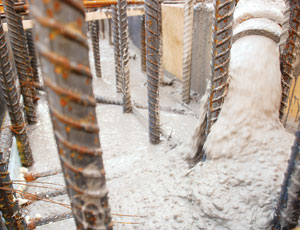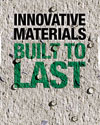Speaking like someone who has run a construction operation before, Juan Carlos Terroba complains about how wasteful and time-consuming a project can be. “Look at how much concrete is tested,” says the former Mexico-based concrete producer. “It’s ridiculous. It goes way beyond your normal quality-control standards.”

Terroba recently left his family’s large, ready-mix business, Productos Cement-eros Mexicanos, to head up iCrete, a private-equity-financed technology company that opened its doors in 2007. Located in the most unlikely of places, inside ritzy Beverly Hills, Calif., iCrete is gaining star status for its lean-andgreen performance on commercial buildings.
It also promises to work well in the infrastructure space, sources say. Like some of the start-ups new to the materials scene, iCrete is not a specific product but rather a process. It was conceived by two scientists in the 1990s, when computer technology and processing power were becoming fast and cheap. By employing complex algorithms, it encourages designers to use performance-based specifications, a growing tool for U.S. infrastructure.
According to the company, the formula helps people working with high-performance concrete get the most bang for their buck. For this reason, iCrete is gaining traction in worldwide commercial construction, most recently at the Freedom Tower in New York City. Even Frank Gehry, who is using iCrete on one of his high-rise projects in New York, is a fan. The firm’s aim is to make concrete more consistent from batch plant to job-site. “Our base technology is a mix design,” says Terroba. “We have imagined a different way of optimizing particle-packing.”
Void control is essential to quality concrete, experts say. Steve Kosmatka, vice president of research and technical services for Skokie, Ill.-based Portland Cement Association, likens the iCrete concept to Starbucks. “They sell coffee, and they turn it into something that people will pay $5 for. It’s the genius of taking the simple and making it really work. It’s good technology, good science.”

In some cases, iCrete’s formula, which is licensed to producers, can yield a high-compressive strength mix that contains 40% less cement and requires no special additives. Though it has initially gained momentum in the commercial-building sector, Terroba envisions iCrete in roads, bridges and structures that must be built to last.
“Over the next few years, the construction that will be taking place in the world will mostly be infrastructure,” he says. “I see the majority of our revenue coming from infrastructure projects.” Long life is key, he adds, noting that iCrete can yield a 100-year design in a mix that is often cheaper to produce and pour. “We’ve achieved more than $50 savings for a cubic yard of concrete of more than 14,000-psi compressive-strength resistance,” Terroba says. “The more sophisticated the concrete, the more our savings.”
Though they rave about its quality for high-strength mixes, users warn iCrete is less forgiving in lower strengths. “I love it, and think it has a home in the industry, but you have to educate the drivers and mixers differently,” says Billy Kell, chief estimator for Sorbara Construction, Lynbrook, N.Y. Finishers also are still getting used to its texture. “You have to work with it differently” he says.



Post a comment to this article
Report Abusive Comment